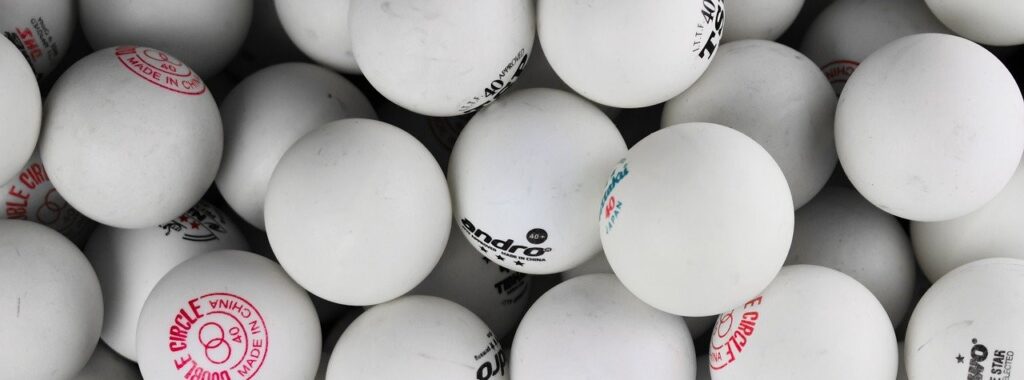There are two types of materials that table tennis balls can be made from: celluloid and plastic. Celluloid balls were the standard until 2014 when they were replaced by plastic. The change was made due to the production issues and transportation costs associated with celluloid.
In this article, I’ll compare the differences between celluloid and plastic ping pong balls and explain why the transition was made and how this impacted the world of table tennis.
Plastic vs Celluloid Balls
Plastic table tennis balls replaced celluloid table tennis balls as the standard in 2014. Plastic balls offer less spin and are slower than celluloid balls. The advantage of plastic balls is that they are less flammable compared to celluloid balls which were problematic to produce and transport.
| Celluloid Balls | Plastic Balls |
| More spin | Less spin |
| Faster | Slower |
| Lower bounce | Higher bounce |
| Highly flammable | Less flammable |

The Two Materials
Before we jump into the comparisons, let’s take a look at the characteristics of plastic and celluloid ping pong balls.
Celluloid Balls
Celluloid table tennis balls were first introduced in 1900, as a replacement for other materials such as cork. The material celluloid itself was first developed in 1870 as a substitute for ivory. Celluloid was the first synthetic plastic materials and it is mad from cellulose nitrate and camphor.
Despite celluloid balls being the standard for many decades, concerns were raised in the last 2000’s and early 2010’s over how flammable they were. This was an issue for both production and transportation leading to increased costs. This created a necessity for their replacement by plastic balls.
Plastic Balls
Plastic table tennis balls began being phased in to official competitions in 2014 and plastic has replaced celluloid as the standard material for making ping pong balls. However, plastic balls were briefly trialled in the 1980’s but they were quickly rejected by players who thought the quality was much poorer compared to celluloid. Their revival came in 2014 due to the issues with celluloid balls.
Although initially criticised for their durability and lack of quality, plastic balls have become much better in recent years and have now been accepted as the standard. The main advantage of plastic balls over celluloid balls is that the plastic balls are not as flammable so they are cheaper and safer to produce and transport.
Physical Differences
So what are the physical differences between plastic and celluloid balls.
Size
Until 2000, all table tennis balls were 1.5″ (38 mm) in diameter, but they changed to 1.57″ (40 mm) in this year which made the balls feel slower and meant they produced less spin. Celluloid balls have a size limit of 39.8-40 mm. Plastic balls are often referred to as poly balls or 40+ balls. This was due to the slight increase in size compared to celluloid. Plastic balls can be 40-40.2 mm in diameter, compared to celluloid balls which can be 39.8-40 mm.
Seams
All celluloid table tennis balls have a seam, however plastic balls can have a seam or be seam-less. The seam is used to join two parts of the ball together. Seam-less ping pong balls are manufactured as a single piece of material. Seam-less ping pong balls have often been criticised for having poor durability and not being perfectly round.
Density
Plastic is a less dense material compared to celluloid. This means that plastic balls have to be slightly thicker or larger to weigh the same as celluloid balls. Here is a table showing the density of each material.
| Plastic (ABS) | Celluloid |
| 1052 kg/m³ | 1400 kg/m³ |

How Do the Differences Impact Playing?
So now we know the physical differences between celluloid and plastic ping pong balls, let’s discuss how this impacts how the ball moves in the air and responds to the paddle.
Speed
Plastic table tennis balls move more slowly through the air than celluloid balls. The difference is minimal, but it’s mostly due to the larger size of the plastic balls which creates more drag.
There was a study by Lee et al., titled “Speed and spin differences between the old celluloid versus new plastic table tennis balls and the effect on the kinematic responses of elite versus sub-elite players”. Here is a link to the full paper. In this study, they found that during flight, before the ball bounced, plastic balls were 3.98% slower than celluloid balls. However, when the ball had bounced, plastic balls were actually 0.69% faster compared to celluloid balls.
Spin
Plastic balls offer less spin compared to celluloid table tennis balls. The same study as quoted above by Lee et al., found that plastic balls offered 3.37% less spin compared to celluloid balls. Before the balls hit the table, the plastic ball had a spin rating of 57.25 rpm, compared to the celluloid ball which had a rating of 59.82 rpm. The same result occurred when the ball had bounced, with the plastic ball having a spin rating of 46.30 rpm compared to the celluloids 48.27 rpm.
Bounce
Plastic ping pong balls bounce higher than celluloid balls when comparing balls with a seam. However, there is some evidence to suggest the plastic balls which are seam-less bounce the least. Most ping pong balls have a a seam though, which is why plastic balls in general bounce higher than celluloid balls.
Durability
Celluloid table tennis balls are more durable than plastic balls. One of the main criticisms of plastic ping pong balls when they were initially introduced was that they deformed and split easily. However, since the introduction of ABS plastic balls, the durability of them has improved in the last few years.
Check out my article on how long ping pong balls last before they need replacing for more info.
How Does this Affect Playing Style?
Plastic table tennis balls generally suit fast-attacking players who do not rely on spin. Celluloid table tennis balls suit players who rely more on backspin and topspin, and usually play more defensively. The switch from celluloid to plastic balls was favoured by fast-attackers but was an issue for players who preferred to use spin.

The Transition from Celluloid to Plastic
Rise and Fall of Celluloid
As mentioned earlier, celluloid balls were first invented in 1900 to replace cork ping pong balls. Celluloid was the standard material used for table tennis balls until 2014 when it was replaced by plastic. At this time, only a couple of factories in Chinese were still producing them.
Celluloid was a problematic material in production as it is highly flammable. This made is more dangerous to produce and also increased transportation costs and times.
Introduction of Plastic Balls
A Chinese factory started producing plastic balls around 2010 as concerns over the future of celluloid grew. The ITTF initially did not approve plastic balls because the difference in construction due to the lack of seam made the normal regulation testing methods unsuitable. However, in 2014, the phasing in of plastic balls and phasing out of celluloid balls was put into place by the ITTF. At the end of 2014 there were over 25 supplies of plastic balls.
Plastic balls were not well received by players initially because the quality was poor and the balls did not have a consistent structure, causing the bounce and spin application to be inconsistent. They were also not very durable and were prone to breaking.
ABS Plastic Balls were Well Received
The introduction of acrylonitrile butadiene styrene (ABS) plastic balls in 2016 was a welcome one, as they meant plastic balls were more consistent and durable. This eased many players’ concerns over the transition from celluloid to plastic balls.
Now it is very difficult to find celluloid table tennis balls because the last supplier of them withdrew approval and by the end of 2020 they stopped being produced.
Despite the transition from celluloid to plastic balls, there were no changes in the rules concerning balls. They still must meet the following criteria:
- 40 mm diameter
- 2.7 g weight
- Matte finish
- White or orange in colour
The ITTF stated in the most recent handbook at the time of writing that the balls must be made from “celluloid or similar plastics”.

Check out my article comparing 1-star, 2-star and 3-star ping pong balls.
References
Lee, M.J., Ozaki, H. and Goh, W.X., 2019. Speed and spin differences between the old celluloid versus new plastic table tennis balls and the effect on the kinematic responses of elite versus sub-elite players. International Journal of Racket Sports Science, 1(1), pp.26-36.
